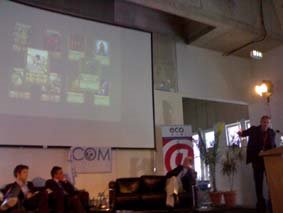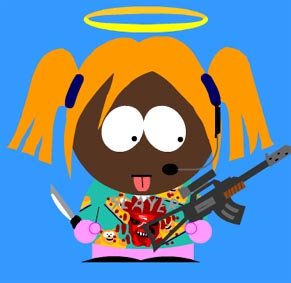Thursday, August 31, 2006
Grrl power
And luckily Nordic Game is not the only torchbearer. Also Comm Tech Lab at the Univ. of Michigan is doing interesting job with 'girls as designers' project. You might also get inspired by:
Bishojo game, Joystick Envy or Japanese style 'girl games'.
Tuesday, August 29, 2006
Ars Electronica

This year University of Arts&Design Helsinki will bring their coolest pieces of media art to Linz and Ars Electronica festival. I will also be there and I am really excited e.g. for pieces/talks by Toshio Iwai. Other than that the programme looks inspiring, exprimental, plentiful covering wide range of digital media. I am sure there will be lots of inspiring issues for game developers as well -- even though games industry still is more conservative and prudent what comes to releases and innovation.
If you go there, do not forget to check Perttu Hämäläinen & Johanna Höysniemi: QuiQui Giant Bounce and Kalle Määttä & co Dignity Nation. See you there!
Sunday, August 27, 2006
Vor dem Spiel, ist nach dem Spiel, ist vor den Spielen
 REDRUM... REDRUM... actually my Cologne experience was far from 'The Shining' (movie). EU-project INCCOM (actually charming Deutche Welle guys) arranged a congress on 24th August at Rheinpalais. We talked about mobile television, football, FIFA06, cross media and the future of games and television.
REDRUM... REDRUM... actually my Cologne experience was far from 'The Shining' (movie). EU-project INCCOM (actually charming Deutche Welle guys) arranged a congress on 24th August at Rheinpalais. We talked about mobile television, football, FIFA06, cross media and the future of games and television.We had an excellent line of speakers from telcos and broacasting companies to SMEs and underground channels. RTL, Vodafone, Yahoo! and Deutche Telecom talked about lessons to be learned from FIFA06. All of those companies had activities during the FIFA06 -- the others had broadcasting or online licences, the others didn't -- but all of them had rather promising news to share with us related to the user figures, online shopping and watching mobile television transmissions. The percentages were still rather low but actually better I had expected.
We also had a session focusing on mobile/digital (virtual) games and gambling. Unfortunately Fraunhofer (Iperg-project), BWin, Gameloft, Plan B and UFA didn't share that many new ideas. Actually the only positive exception was Michael Rueger from UFA. He talked about Master of Maya mobile MMOG trading card game -- hmm... Even though I believe in mobile minigames, I think this Maya-thing could have possibilities in the mobile world. Michael also brough up some of his favourites such as augmented reality stuff done by Adrian Cheok et al at the Singapore University (actually we do pretty same (and as impressive) stuff at the VTT). Also SMS to smoke, Mattel's Miau and SMS HugMe are -- if not blockbusters -- at least funny experiments.

I also learned that Katrin Bauerfreind from ehrensenf.de (iTV channel) had attained rather impressing audience. That was also one answer to the debate about the future of television. Cross media and internet publishing are must as well as segmenting news and reaching new user groups such as youth.
That's about it in brief. Oh, I forgot to mention the discussion whether mobile television standard is doing to be DMB, DVB-H or DxB... but I quess we'll figure it our sooner or later.
Thursday, August 24, 2006
'Nothing is too weird for us'
 Greetings from Cologne! I came here to attend 'Ahead of the game, is after the game, is ahead of the games' event where the discussion will dwell around cross media, entertainment, football and mobile television. The rallying point of those words is EU-project INCCOM.
Greetings from Cologne! I came here to attend 'Ahead of the game, is after the game, is ahead of the games' event where the discussion will dwell around cross media, entertainment, football and mobile television. The rallying point of those words is EU-project INCCOM.This project aims at gathering the experience from selected organizations and research projects in the area of cross-media content in order to stimulate the commercial exploitation of innovations as well as to focus research activities. The INCCOM project will be examining the latest technical achievements, highlighting the opportunities within a football framework and discussing user relevance and potential.
I am expecting fresh viewpoints to cross media entertainment (from mobile television viewpoint) because there is an interesting list of presenters: Barbara Gessler (EU), Robert Fahle (RTL Mobile Media), Sandra Frundt (Vodafone), Christian Muche (Yahoo Fifa partnership) and Ulf Morys (Gameloft) to name a few discussing about the topic(s).
 And to shed some light on the title of this post... I just love luxury hotels because they really have it all. Let's put it this way: aromatherapy shower cap is not the weirdest 'special' thing in my room...
And to shed some light on the title of this post... I just love luxury hotels because they really have it all. Let's put it this way: aromatherapy shower cap is not the weirdest 'special' thing in my room...
But that is (at least for some) one reason to choose super expensive hotels instead of ok ones.
Tuesday, August 22, 2006
The Future of Digital Entertainment
Of course I am happy to know that 'The Dutch market currently has the highest broadband penetration of the markets under examination and is expected to retain this position through to 2008' and 'The mobile phone is best placed to be THE converged device of the future' (ooh interesting...).
This report must have costed some thousands of euros... Well, there actually are a couple of remarks about games. I would like to share them with you.
- 'The game playing converged device is likely to dominate the PCJ (Personal Content Jukebox) market – with the Sony PSP well positioned for market dominance. But consumers are likely to relatively ignore the video playback features, and focus on its gaming capabilities.' FULL STOP. Here you have it.
- Interactive TV games and gambling business models are among the most successful value-adding services launched by digital TV operators and channels. In 2004 the Western European iTV games and gambling markets together generated $1.18bn. However, the market will grow rapidly, generating $3.6 billion in 2007 as an increasing number of platforms launch services and uptake and usage of iTV games and gambling services grow (see Figure).
Next I' ll devour the 'Targeting the single female consumer'... Who knows what I'll learn!
ll devour the 'Targeting the single female consumer'... Who knows what I'll learn!
Monday, August 21, 2006
Kids with mobile phones
Also youth are one the move. According to Pelastakaa Lapset report 'Kännykamera käy!' (2005) (and yes, it's in Finnish) 84 % of 7 - 9 year olds have their own mobile phones. Almost every 10+ year old has a mobile phone or even two.
To the question: 'for what purposes did you use your mobile phone yesterday': It is no surprise that talking (F 80 /M 86 %) and SMS (F 75 /M 66%) were the most popular services for 7 - 15 year olds. The interesting (and news for me) thing was that according to the study 47 % of 7 - 9 year olds used their phone to play games. Compared to the older age groups (10 - 12, 13-15 year olds) that is quite a lot as the older respondents did not use a mobile phone for gaming as much (=24,5 %) as 'kids'. Also photography was popular amongst the youth (average F 19 /M 25 %) .
Other than media use there has been some talks about SMS bullying, mobile creativity, novel services, the success of TV-SMS services and mobile tv. Other than services, I also waiting for Nuorisotutkimusverkosto (Finnish Youth Research Network) to finish their comparative report on mobile phones & youth in South Korea, Japan and Finland.
Sunday, August 20, 2006
Blast from the past (+musical madness)

While others are sweating at Finncon06 or at a tennis field I am chilling & feeling sentimental with Taito-the-dog and listening J-Pop.
In my CD player:
Spitz (Mahô no Kotoba/Shalala) single (July 2006). The cover of their newest single is super cute! Actually I bought the single just because of the cover. Well, I quess that is not super exceptional. But I have to say that I really love the flowers, four-lead clovet, hugging ladybird (especially!) and 'Nuuskamuikkunen (guy)'. Really nice piece
 of art. And the record is not bad either -- melodic pop/rock. I like it a lot (inside/outside).
of art. And the record is not bad either -- melodic pop/rock. I like it a lot (inside/outside).I admire P. J. Harvey and dig her records. Now I have found 'Japanese P.J.' named Cocco :) Actually it is somewhere in between Fiona Apple and P. J. but anyhow. Pretty impressing, plentiful and surprising even. I am currently listening her newest: Swinging Night album.
 My third pick is mainly for Tanja (the sentimental part of this post) -- to remind you that people are versatile, they have their past and even though the past is not that strongly brough forward -- many bits&pieces of the past are building blocks of the present. Diarium Autopsia was a fanzine published in the beginning of the 1990s. I did it together with my dearest Heidi and we wrote about the coolest death/doom/trash/grind/black metal bands of those days. To highlight some: we did an interview with Mike Patton (Mr. Bungle) and several bands that still exists (Amorphis, Napalm Death, My Dying Bride, Ancient Rites, Paradise Lost etc. etc).
My third pick is mainly for Tanja (the sentimental part of this post) -- to remind you that people are versatile, they have their past and even though the past is not that strongly brough forward -- many bits&pieces of the past are building blocks of the present. Diarium Autopsia was a fanzine published in the beginning of the 1990s. I did it together with my dearest Heidi and we wrote about the coolest death/doom/trash/grind/black metal bands of those days. To highlight some: we did an interview with Mike Patton (Mr. Bungle) and several bands that still exists (Amorphis, Napalm Death, My Dying Bride, Ancient Rites, Paradise Lost etc. etc).
Saturday, August 19, 2006
Games @ Finncon 06

I attended to 'SF and fantasy in video games' session at Finncon06. All six (5 + chairman) members ofthe panel were SF/fantasy/fiction geeks plus video games players so there really weren't any dramatic differences between their opinions about good/bad games, qualities of playability/game experience, cut scenes or lessons-to-be-learned from fantasy novels. Luckily Jyrki J. J. Kasvi and Frans Mäyrä were invited to the panel. Even though they talked pretty much the same story as the others, Jyrki with his suberb, diverse and long-term experience of games (as reviewer, father, gamer, researcher and politician) and Frans with his worthwhile comments from the game research scene enriched and deepened the conversation.
I am not really a fan of panels as panels usually tend to be rather lame due to bad chairmanship, too wide topics, domineering panel members etc. This time it was ok (just ok). It didn't offer 'gushing testosterone' as advertised and it did not bring that much novelty to the topic but it was rather entertaining and knowhing. I hope the tradition continues with more diverse set of speakers (maybe a mix of Animecon specialists, gamers, fantasy freaks... ?
Besides the panel: To put it short: very beautiful (jugend) assembly hall, sunny day, awful chairs, great bunch of people, cool guys/girls and large number of cosplayers. :D
Wednesday, August 16, 2006
Educational games

Back in 1998 I discovered edugames / edutainment. It was a whole new world of digital games offering lots of potential for game developers (at least in theory). The discussion dwelled around "is it a game containing didactic message or is it a learning tool utilizing gameplay in some way". "Is it 80/20% or 50/50%" etc. What ever the case: fearless edugame developers soon learned that there were no existing market channels (at least not effective enough) and the CD-ROM market was already fading...
I listened two inspiring presentations about edugames at the WiG06. Also I have pondered the case (the big picture about education / learning + games) again after I got invited to give a Podcasting chat (with Annakaisa Kultima) at Leipesi (Play, Games & Simulations) course at the University of Lapland. Even though I am not talking about edugames at the upcoming podcast, edugames give interesting viewpoints to the whole topic of 'the future of digi-games'. Today the approach is more open minded and innovative (in the way of utilising technological tools and devices as well as due to social multiplicity of the Internet.
It's nice to notice that today 'edugames' (serious games, beneficial games, utility games) focus on learning in a wider sense. While at the end of 1990s the main focus was in schooling, basic training and subjects at school -- today the focus is more on tutoring, educating and instructing. The topics do not limit to school subjects, instead some of the nicest 'edugames' talk about wellbeing or healthy diet and change in climate.
Some examples and related web sites:
Learning Planet
The Learning Game
MyPyramid.Gov
Millsberry
Eco Kids
And one my ultimate favourites: NHK's Antarctica. I am so obsessed with those penguins :D
Tuesday, August 15, 2006
Create your own games
This is a short list of game editors which allow (almost) anyone to design or modify their own games.

Two most used / discussed ones:
Game Maker
Game Editor
Others:
RPG Game Creator
Torque Development Platform
Stagecast
Pesticide Peril Game Creator
You can also start by designing characters--perhaps in a South Park style.
And there is always MUPE if you are a bit more advanced game programmer (compared to level zero)
Monday, August 14, 2006
Technology trends
"The whole point of Enterprise Web 2.0 is to put best practices for creating Web experiences into the hands of business people, Web designers, and users so that we make the most of the systems, users, and information that we have. For example, the vast, aging inventories of otherwise userful information is one of the bigger wastes in IT today. Web 2.0 encourages us to put it all online, make it user organizable, findable, and to build a community around it."
ArsTechnica:
"Gaming is arguably one of the most interactive and progressive electronic entertainment mediums in existence today. As innovative new gaming concepts stretch the limitations of current technology, developers are looking for unique ways to make games more immersive and engaging. As the cost of producing content increases, and player demand for a broader selection of content continues to escalate, developers are searching for new ways to allow gamers to participate in the creative process, by facilitating player-driven construction and distribution of new content."
Emosiveness:
"emosive (formerly e:sense) is a new service for mobile devices which allows capturing, storing and sharing of fleeting emotional experiences"
Some trends quessed by CNN
"Driven by ubiquitous broadband, cheap hardware, and open-source software, the Web is mutating into a radically different beast than it has been. And that is leading to the creation of entirely new kinds of companies, new business models, and oceans of new opportunity."
Visual communication, Tokyo Game Show, NordicGame
Instead there will be no huge Finnish delegation at the Tokyo Game Show (at least Neogames will not arrange a trip to Tokyo because of lack of participants). Tokyo Game Show with open its doors at Makuhari Messe just two days after NordicGame.
I am expecting to see inspiring presentations related to mobile games / communities / participatory ideas. Perhaps something like Goscube's mobile quiz? Featuring creative ideas like enabling the users to participate in a broadcast program together with an announcer character. Luckily there is enough space for mobile innovations in Japan because mobile phones and PSP really need one (or a few).
Friday, August 11, 2006
AARGH: kiertokirje!
1. Yksi kirja, joka muutti elämääsi:
Jorge Amado: Kirjava Kissa ja Tytti Pääskynen. Kirja oli visuaalisesti mainio ja tarinana valloittava. Ei ehkä kovin deathmetallia, mutta silti monella tapaa tuskaisen hieno. Aikuisenpana ei ole moista kirjaa tullut eteen. Kirjakauppiaan mielestä Alkemistin pitäisi olla elämää muuttava kirja. Minusta se oli kökkö. (Oho tuli kaksi mainittua.)
2. Yksi kirja, jonka olet lukenut useammin kuin kerran:
Aku Ankan taskukirja(t).
3. Yksi kirja, jonka tahtoisit mukaasi autiolle saarelle:
Tyhjä päiväkirja täytettäväksi.
4. Yksi kirja, joka teki sinusta hupakon (giddy):
Äh, enhän minä sentään. Ehkä Anselmus-tarina, jos joku pitää mainita (E.T.A. Hoffmann: Kultainen Malja). Anselmus oli aika hullu.
5. Yksi kirja, joka sai sinut puhkeamaan kyyneliin:
Kovat tytöt ei itke. Sitä paitsi luen liikaa tiedekirjoja.
6. Yksi kirja, jonka toivoisit tulleen kirjoitetuksi:
Omaa tuotantoa oleva mielettömän hieno arjen fantasiaan uppoava kirja.
7. Yksi kirja, josta toivot, ettei sitä olisi koskaan kirjoitettu:
Ei sellaisia kirjoja ole. Antaa kaikkien kukkien kukkia.
8. Yksi kirja, jota luet paraikaa:
Haruki Murakami: Elephant Vanishes
9. Yksi kirja, jonka olet aikonut lukea:
T. L. Taylorin Play Between Worlds, Edward Castronova: Synthetic Worlds (taas tuli kaksi).
10. Nyt haasta viisi bloggaajaa:
Noku en (auts, alasin päähän)
(theory & practice of) User generated content
[David Harper: User-Generated Content: Killer App Of Mobile. WinkSite 3 Nov 2004]
(this is how they create hypes. As voice and text is no content at all whatsoever, we need CONTENT and fast!) :D
Google Alert has dutifully informed me about 'user generated content' and 'users as innovators' related articles/news/posts since September 2005. Lately the number of hits has grown exponentially. I quess I should thank all those social media, lead user and web2.0 enthusiasts who reinforce the inevitable hype of social media (/games).
This seems also to be a great moment to make a skewed/biased/inadequate summary of ***theory + practice of USER GENERATED CONTENT***.
in theory:
According to Wikipedia: User Generated Content is a term that has come into the mainstream during 2005 in web publishing and new media content production circles. It refers to on-line content that is produced by users of websites as opposed to traditional media producers such as broadcasters and production companies. It reflects the democratisation of media production through new technologies that are accessible and affordable. These include digital video, blogging, podcasting, mobile phone photography and, of course, wikis.
If you are new to the discussion you should google 'lead user', 'users as innovators' or 'informal innovation' plus 'tool kits'.
Another great starting point is Eric von Hippel's website. Eric is the brightest guru of user innovation studies. He has done many inspiring case studies related to the topic since the 1970s.
Other researchers/professors/writers (this is not an exhaustive list!!!): Christian Lüthje, Cornelius Herstatt, Peter Magnusson, Mary Sonnack, Sonali Shah, Karim Lakhani, Pia Helminen, Per Kristensson... See e.g.
http://www.tim.wi.tum.de/home/index.php?option=com_docman&task=cat_view&gid=56&Itemid=90
in practice:
One easy example is fan culture: there has been fanzines since I don't know when, currently many Habbo Hotel fans publish their Habbo fan sites, fan art, stories... Some clever entrepreneurs/companies have also utilized fans to develop their digital content further.
There are also companies like GoFresh (http://www.gofresh.de/business/itsmy-8.html) with their itsmy.com. Flick.com is an excellent example of user generated content. I am sure you know eBay already. The basic philosophy of Wikipedia is based on user generated content / community ideas. FourDocs is rather nice one (home made docs). Blogging is also a part of the big picture. In classmates.com / koulukaverit.fi / inttikaverit.fi the core of the content is created by the users not to mention Plazes.com, LinkedIn, Amazon.com (back then the talk was circulating around data mining / personalisation)... A few years back tsunami in Thailand was broadly and trustily enough reported by 'users' aka amateurs aka AverageJoes.
Game developers (too) have noticed that they can save money and time when releasing early beta versions to hard core fans and enthusiasts. In MUDs advanced users (~wizards) can develop the world further. Graphical online game developers currently provide tool kits for the users to modify the game worlds, characters etc.
Let''s see what web2.0 developer come up with when it is common to use the Internet via a mobile phone. A lot of new possibilities to marvel.
The value of user generated content? Read this article: http://www.intranetjournal.com/articles/200603/pij_03_07_06a.html
My new best friend trend-watching.com has a word to say about this as well: http://www.trendwatching.com/trends/CUSTOMER-MADE.htm
Wednesday, August 09, 2006
Building blocks of a virtual community
Community
- a group of people having something in common: area, ethnic or cultural or religious characteristics, ownership, common interests, profession, interest (goal), ecology. (Source: http://wordnet.princeton.edu/perl/webwn)
EscapismIt is easy to understand why people may think digital games as escapism (Escapism Lite, if you like). But is WoW or Assembly escapism? If so, in what way? I would say Pachinko and virtual reality (VR) definitely are types of escapism offering total immersion into the game worlds (noisy Pachinkos, immersive 3D VR worlds).
The desire to retreat into imaginative entertainment rather than deal with the stress, tedium, and daily problems of the mundane world. (Source: http://wordnet.princeton.edu/perl/webwn)
Virtually social interactions (communities)
Virtual communities are social aggregations that emerge from the Net when enough people carry on those public discussions long enough, with sufficient human feeling, to form webs of personal relationships in cyberspace. (Source: Rheingold, 1993, The Virtual Community)
 But online games and gaming events mainly tend to bring enthusiasts together to have fun and compete with each other. Definitely there is a certain level of devotion and 'contentual escapism' in games otherwise people would not play them. One looks after pleasure and emotions from a game (or a book/a movie). But that is not escapism it is a way to feed one's imagination. A way to explore and experience new things and different emotions. Could it be experientalism instead of escapism?
But online games and gaming events mainly tend to bring enthusiasts together to have fun and compete with each other. Definitely there is a certain level of devotion and 'contentual escapism' in games otherwise people would not play them. One looks after pleasure and emotions from a game (or a book/a movie). But that is not escapism it is a way to feed one's imagination. A way to explore and experience new things and different emotions. Could it be experientalism instead of escapism?Is contentual escapism a must have in virtual communities (if the building blocks of a virtual community are as follows):
1) Meaning and purpose to use the service
2) Limits, rules (etiquette)
3) Tools (for users)
4) Possibilities (alternative routes)
5) History (events, development of social relationships)
6) Members -- of course
7) Dynamic nature of the virtual world (changes, cyclic active and passive periods)
8) Trust
9) Sharing (information, items, knowledge, material)
10) Trading (information, items, knowledge, material)
Contentual escapism sounds like a sibling to social interactions in online (or mobile) worlds. Perhaps the talk should be about the differences between 'negative' and 'positive' (contentual) escapism and how escapism is different from one's imagination or creativity? What type of escapism is essential in able to make a virtual community work?
Further reading: http://www.escapistmagazine.com/issue/57/19
Monday, August 07, 2006
Quite a bit of talk about mobile game development
Nokia (NRC) is arranging an afternoon-long workshop (5th Sept.) on current and future development of mobile games.
>> http://research.nokia.com/workshops/games-day-2006/index.html
Games&Storytelling lecture series will also continue (in September) with interesting speakers such as Chris Crawford, Sandy Stone, Nour Khais and Larry Friedlander.
>> http://www.gamesandstorytelling.net/
Sunday, August 06, 2006
YOUniversal
'Gaming, whether online, mobile or console-based, lets players be a part of the storyline and live in an alternative reality. It allows the player an experience that generated real emotions.' This type of opinions highlight (at least I think they do) the great distance between 'spectators' (READ: adult) opinion' and 'participants opinion'. Many online gamers or chatters consolidate their presence, their opinions and their position in the real world through online communities. One plays with her/his virtual identities, one may establish her/his self-esteem and one just hangs around at the virtual communities. It is not about alternative reality, it is about extensions of real life reality. Habbo Hotel, IRC or Lineage might be just an additional way to communicate and spend time with friends. It is not about escaping the REAL world, it is about creating different ways to communicate with friends. For some the Internet offers excellent -- ADDITIONAL -- channels to share the hidden secrets with friends. Some young have said that they spend a lot of time with their friends IRL and at online worlds but they speak about different issues online than IRL. And some issues discussed online will not be discussed offline. I think (in one way) this highlight the very essence and role of online communities not as an alternative reality but as a part of 'the real world'.
The point of the article was that one should utilise this new consumerism (e.g. proam, prosumer) movement when branding online products. In-game advertising is expected to reach US$ 732 mln by 2010 (Yankee Group) and more than 100 million people worldwide log on every month to play interactive computer games (NYT, Dec2005). 60% of trendsetters and 33% of mainstream 14-34 year olds have a social networking page (TrendCentral, May2006). How about that?!
If you are into online communities and branding / marketing, you should check the article but also websites like:
- Habbo Hotel
- Neopets
- Virtual Magic Kingdom
- Goonzu
- Guild Wars
- Project Entropia
- Second Life
- WoW
- Ragnarok Online
Saturday, August 05, 2006
A few words about WiG 2006
1. Give a voice to women in the games industry.
2. Analyse and monitor the role of women in the games industry.
3. Provide networking opportunities, especially for women developing and researching games.
4. Support and encourage students, researchers and developers to explore and redress the game industry's gender imbalance.
5. Disseminate research into games (past, present and future), especially (but not exclusively) with reference to the experience of women playing, developing and responding to games and game culture.
6. Disseminate information on the latest technologies and the best design and development practices (from: http://www.womeningames.com/).
Even though (IMHO) the conference was weakly advertised there were 50+ participants -- most of them from the Scandinavia and the UK. The focus of the conference was more on educational and QoL issues. For me the most rewarding presentations were Click2005! (Betsy DiSalvo&Anuja Parikh) and Agent O by Elisabet Nilsson. Both presentations described playable, 'ubi-comp' LBS-applications which itself were actually nothing that special. The same ideas have already been explored in UncleRoy All around you, Can you see me now?, Urban tapestries, NodeRunner, MobileHunt, Pirates! etc. etc. Anyhow the nice things about Agent O and Click 2005!: 1) they focused on 'users-as-innovators' (I believe in users as innovators to be the future for games as well) and 2) they had a fresh ideas how to use games in schools / to enable more free and active learning. At least Agent O - probably also Click! will be developed further. (Also super-nice and charming Mirjam Vosmeer's presentation was somewhat related to these mentioned, if you are into prosumerism, educational game design you should definitely follow what Mirjam is up to!)
My own presentation was about girls' game clubs, users as innovators (what a surprise!) and participatory game design. I wrote a short paper describing my work. The work continues. All commentators will be highly cherished :)
Tuesday, August 01, 2006
Game treats from Japan
 Greetings from Japan. Even though game markets in APAC, Europe and N-America are somewhat coming closer or at least the boundaring are blurring a bit -- thanks to the Internet, erasing of regional codes (PSP etc.) and active (online) game communities, there are still some things that are very Japanese. Pachinko is apparent but also the visibility of media art (influenced by games) and digital games in everywhere life is something I have not seen anywhere else (except South Korea in someway (>> being game tournaments played at the malls, PC pangs, and subway stations but that's about it).
Greetings from Japan. Even though game markets in APAC, Europe and N-America are somewhat coming closer or at least the boundaring are blurring a bit -- thanks to the Internet, erasing of regional codes (PSP etc.) and active (online) game communities, there are still some things that are very Japanese. Pachinko is apparent but also the visibility of media art (influenced by games) and digital games in everywhere life is something I have not seen anywhere else (except South Korea in someway (>> being game tournaments played at the malls, PC pangs, and subway stations but that's about it).LocoRoco (PSP) was very well exposed where as Gitaroo Man (PSP) was surprisingly slightly promoted. First I though it has not been published yet but it was -- and I can assure you it is a cool rhythm game :) Those travelling to Tokyo: if you did not know the Playstation showroom (previously on 6th floor of the Sony Showroom) has moved. Now there is only the lobby (Playstation square) of Sony Computer Entertainment Headquaters near Aoyama subway (exit A5) where one can play some PSP and PS2 titled as well as wonder 'Playstation signature brand' items. Luckily there are also Playstation Spots in Japan (see: http://www.jp.playstation.com/psp/pss/).
 For retro gamers and (hw/sw) game collectors, Super Potato is the place to go. It is located in Akihabara (Tokyo) and there is also another shop in Osaka. This place can be daunting for some -- especially those who have paid lots of money at the Ebay for some 'rare' game consoles or software as the shelfs of SuperPotato were full of 1970s and 1980s game consoles, VirtualBoys and game music (though some must-have cds were super-expensive!!)
For retro gamers and (hw/sw) game collectors, Super Potato is the place to go. It is located in Akihabara (Tokyo) and there is also another shop in Osaka. This place can be daunting for some -- especially those who have paid lots of money at the Ebay for some 'rare' game consoles or software as the shelfs of SuperPotato were full of 1970s and 1980s game consoles, VirtualBoys and game music (though some must-have cds were super-expensive!!)There are very interesting and wide selection of Nintendo Game&Watch devices also for tight-fisted :) And for those looking for interesting (relatively) new releases Gameboy Micro has really-really addictive games!
 'Girlgames' and girls as gamers is still an interesting topic even though a lot has happened within the last 10 years [also in Finland]. The number of girlgamers is on the rise and according to VTTs survey (January 2006): "Only 2% of boys and 12% of girls state that they do not play digital games at all. Majority of boys (67%) play digital games daily or almost daily where as 20% of girls play games daily or almost daily." Check a summary of the findings from my other blog: http://exergame.blogspot.com/
'Girlgames' and girls as gamers is still an interesting topic even though a lot has happened within the last 10 years [also in Finland]. The number of girlgamers is on the rise and according to VTTs survey (January 2006): "Only 2% of boys and 12% of girls state that they do not play digital games at all. Majority of boys (67%) play digital games daily or almost daily where as 20% of girls play games daily or almost daily." Check a summary of the findings from my other blog: http://exergame.blogspot.com/ Horse back riding games were surprisingly popular. But it was no 'girlgame' -- ALL of the gamers in EVERY game room we visited were young men! There w
Horse back riding games were surprisingly popular. But it was no 'girlgame' -- ALL of the gamers in EVERY game room we visited were young men! There w ere two types of riding games. The one at the photo is closer to betting/trotting-race though it also included 'virtual pet' part where the gamers were caressing and feeding their horses . The other game was similar to the ones at the amusement parks where tiny (material) horses run round the circuit.
ere two types of riding games. The one at the photo is closer to betting/trotting-race though it also included 'virtual pet' part where the gamers were caressing and feeding their horses . The other game was similar to the ones at the amusement parks where tiny (material) horses run round the circuit.Shooting, driving and rhythm games, as well as reflex, luck and 'prinkla' print seal machines were still hugely popular at the Sega, Namco, Taito etc. game rooms but there were also some weird games like Wok game. Eh... yeah. It must have been fun to design a game like this :)
W
 e also visited NTT Communications Art x Communication=Open! exhibition. It was super interesting exhibition with many inspiring pieces. Just to mention some: onebuttongame_Blanco (2004) and loopScape (2003) were really nice ones. onebuttongame_Blanco games were played just by pressing one button
e also visited NTT Communications Art x Communication=Open! exhibition. It was super interesting exhibition with many inspiring pieces. Just to mention some: onebuttongame_Blanco (2004) and loopScape (2003) were really nice ones. onebuttongame_Blanco games were played just by pressing one button . It might sound a bit dull but it was actually quite meditative and addictive. loopScape is like a simplistic Darius (horizontally scrolling shoot'em up). In this game the screen is a sylinder and players have to move around (the cylinder) and pilot their space ships. It's a lot of fun!
. It might sound a bit dull but it was actually quite meditative and addictive. loopScape is like a simplistic Darius (horizontally scrolling shoot'em up). In this game the screen is a sylinder and players have to move around (the cylinder) and pilot their space ships. It's a lot of fun!
Hybrid media (combination of printed and digital media) has been a hot topic in Japan and Finland for some years already. I am sure many of you have seen 1D (bar codes) or 2D ( aka matrix codes, semacodes) used in different ways. Most often 2D code contains an URL address. By reading the code with a mobile phone [camera], one can automatically go to a specified web site, get a game patch or an advertisement. There was quite nice hybrid media solution at the Sony Building lobby in Tokyo. One could get information about the stores by tilting the paper sheet under a camera. As a result of this, one will see a 3D model of the building on a screen (see photo) as well as images and short description of the shops etc.


